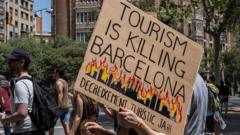Following a massive blackout that left much of Spain in chaos, the nation diligently worked to restore power. Experts analyze the causes and the need for systemic changes to prevent future outages.**
Spain's Power Revival: Rebuilding the Grid After Catastrophic Blackout**

Spain's Power Revival: Rebuilding the Grid After Catastrophic Blackout**
An in-depth look at Spain's recovery from an unprecedented national blackout and the challenges ahead for its energy system.**
The country of Spain has embarked on a recovery mission after experiencing one of the most significant blackouts in its history. As daily life begins to resume, the focus shifts toward understanding the underlying issues that led to this unprecedented power failure, as well as strategizing on preventative measures for the future.
On Monday, chaos enveloped Spain, resulting in a stark loss of power that took nearly a full day to address. By 11:15 a.m. on Tuesday, Spain's electricity grid finally announced that normal operations had resumed after the extensive outage that began the previous day. While Spain's trains have gradually returned to service, some routes remain temporarily suspended. Many homes regained electricity, but the dust has yet to settle on the larger implications of this event.
The blackout, as identified by government officials including Prime Minister Pedro Sánchez, stemmed from two connection failures in southwestern Spain, coinciding perfectly with a disconnection from the French electricity network. At approximately 12:33 p.m. on Monday, the sudden loss of 15 gigawatts plunged around 60% of Spain's power generation into darkness. Eduardo Prieto, the director of operations for the grid operator Red Eléctrica, confirmed that despite prior stability in the system, the unexpected drop in generation was catastrophic.
While regions such as the Canary Islands, Balearics, Ceuta, and Melilla remained unaffected, the overwhelming reliance on solar power has drawn scrutiny. Before the blackout, around 60.64% of Spain's electricity was derived from solar photovoltaics, complemented by 12% from wind and 11.6% from nuclear sources.
As the crisis unfolded, authorities and energy experts focused on a meticulous restart process to avoid further strain on the system that could lead to a secondary blackout. The initial push was made towards hydro-electric plants, particularly pumped-storage plants with sufficient resources available for rapid electricity generation.
Spain's neighbors facilitated support: Morocco supplied 900 megawatts through high-voltage lines, while French operator RTE contributed an increasing amount of power to the grid, ultimately reaching up to 2,000 megawatts. Thankfully, by Monday evening, significant progress had been made in restoring power; approximately 3.5 million customers saw their electricity restored before midnight.
As Spain begins to tally the financial toll of this incident, estimates suggest a €1.6 billion hit to the economy. Political leaders have already engaged in the blame game. Some politicians criticized the government's responsiveness and the effectiveness of its energy policies.
Despite the turbulence, the Spanish populace was commended for their collective resilience. Emergency services, such as Spain's Guardia Civil, successfully rescued thousands of travelers stranded in transit. Supportive communities stepped up, assisting those affected by train delays. While airports continued operations using backup generators, many in Spain found themselves cut off from information as phone batteries drained and power outages forced reliance on battery-operated radios.
In light of this crisis, Prime Minister Pedro Sánchez is committed to ensuring that Spain learns lessons from this disaster, but experts express concern that vulnerabilities within the energy infrastructure might still pose risks due to the ongoing integration of renewable energy sources. As discussions about future regulations intensify, citizens and officials alike await a comprehensive review of Spain's energy strategy to maximize reliability while minimizing risk in the years to come.
On Monday, chaos enveloped Spain, resulting in a stark loss of power that took nearly a full day to address. By 11:15 a.m. on Tuesday, Spain's electricity grid finally announced that normal operations had resumed after the extensive outage that began the previous day. While Spain's trains have gradually returned to service, some routes remain temporarily suspended. Many homes regained electricity, but the dust has yet to settle on the larger implications of this event.
The blackout, as identified by government officials including Prime Minister Pedro Sánchez, stemmed from two connection failures in southwestern Spain, coinciding perfectly with a disconnection from the French electricity network. At approximately 12:33 p.m. on Monday, the sudden loss of 15 gigawatts plunged around 60% of Spain's power generation into darkness. Eduardo Prieto, the director of operations for the grid operator Red Eléctrica, confirmed that despite prior stability in the system, the unexpected drop in generation was catastrophic.
While regions such as the Canary Islands, Balearics, Ceuta, and Melilla remained unaffected, the overwhelming reliance on solar power has drawn scrutiny. Before the blackout, around 60.64% of Spain's electricity was derived from solar photovoltaics, complemented by 12% from wind and 11.6% from nuclear sources.
As the crisis unfolded, authorities and energy experts focused on a meticulous restart process to avoid further strain on the system that could lead to a secondary blackout. The initial push was made towards hydro-electric plants, particularly pumped-storage plants with sufficient resources available for rapid electricity generation.
Spain's neighbors facilitated support: Morocco supplied 900 megawatts through high-voltage lines, while French operator RTE contributed an increasing amount of power to the grid, ultimately reaching up to 2,000 megawatts. Thankfully, by Monday evening, significant progress had been made in restoring power; approximately 3.5 million customers saw their electricity restored before midnight.
As Spain begins to tally the financial toll of this incident, estimates suggest a €1.6 billion hit to the economy. Political leaders have already engaged in the blame game. Some politicians criticized the government's responsiveness and the effectiveness of its energy policies.
Despite the turbulence, the Spanish populace was commended for their collective resilience. Emergency services, such as Spain's Guardia Civil, successfully rescued thousands of travelers stranded in transit. Supportive communities stepped up, assisting those affected by train delays. While airports continued operations using backup generators, many in Spain found themselves cut off from information as phone batteries drained and power outages forced reliance on battery-operated radios.
In light of this crisis, Prime Minister Pedro Sánchez is committed to ensuring that Spain learns lessons from this disaster, but experts express concern that vulnerabilities within the energy infrastructure might still pose risks due to the ongoing integration of renewable energy sources. As discussions about future regulations intensify, citizens and officials alike await a comprehensive review of Spain's energy strategy to maximize reliability while minimizing risk in the years to come.























